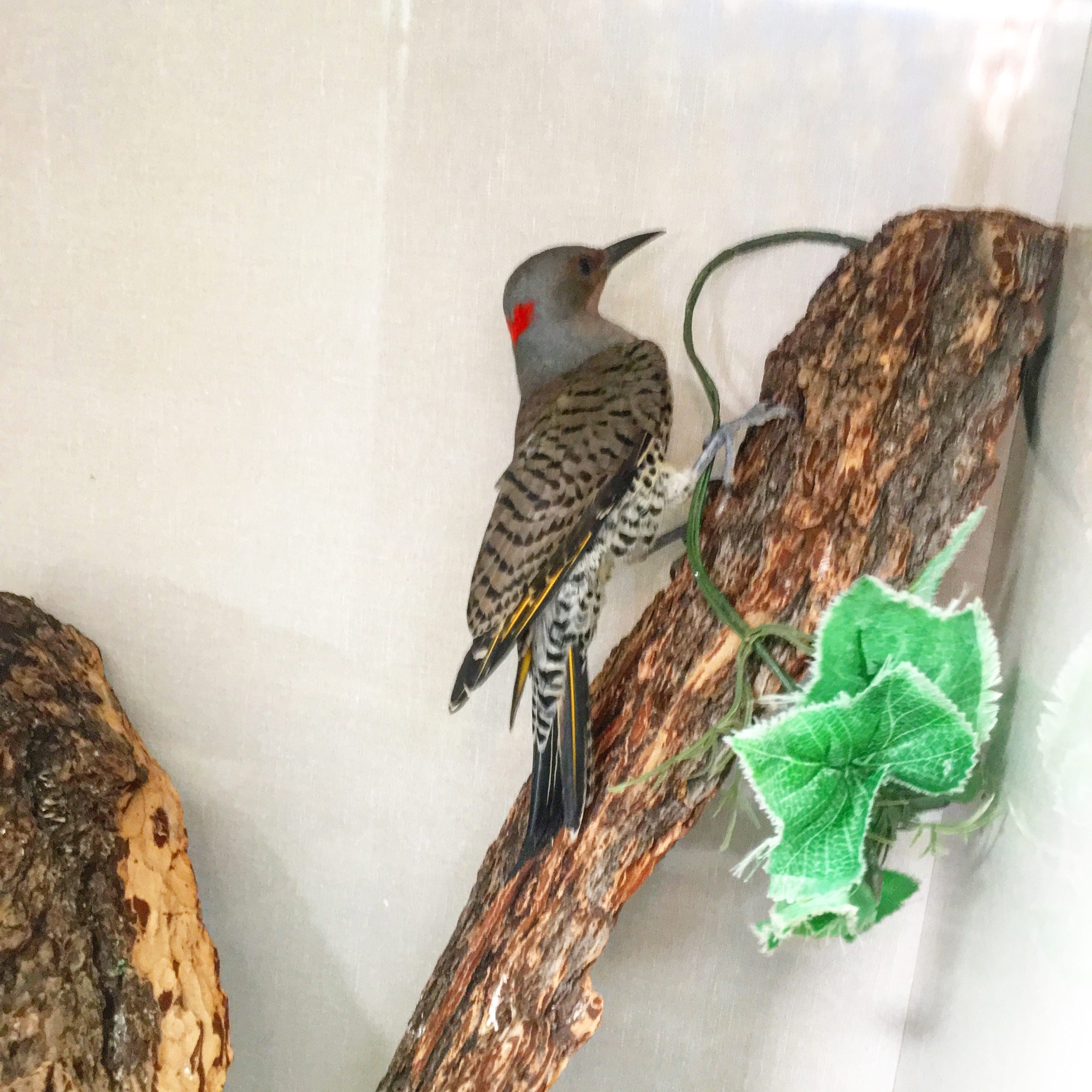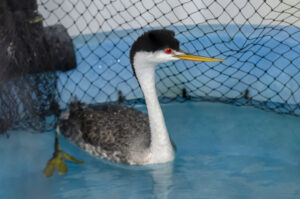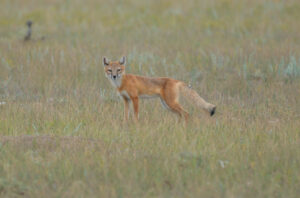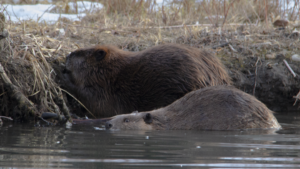Despite being classified as a woodpecker, don’t be surprised if you startle a northern flicker up from the ground on your next hike! These striking auburn birds use their specialized beaks to dig up dirt and a 2-inch long tongue, which wraps around the flicker’s skull when retracted, to extract insects and larvae. These birds will also eat fruit and seeds, especially over winter when ants in particular become harder to find. In the spring, northern flickers can be heard drumming on tin flues, siding, gutters, and other materials to attract mates.
Both males and females help to excavate dead or diseased trees for nests, which will be lined with little more than a thin layer of woodchips for a clutch of 5-8 eggs. Northern flickers are quite happy in nest boxes and in reusing tree cavities created by other animals. Nestlings will tend to cling to the wall of their nest between the second to third week after hatching.
These hardy birds are brown in colour with dark spots and a black collar. The nape of their neck is highlighted with a deep red crescent. In flight, bright feathers on the underside of the northern flicker can be seen. These feathers are orange in the red-shafted flicker subspecies of western North America and yellow in the yellow-shafted flicker that dominate further east and north.
Northern flickers cover a large range across most of North America and can be found in suburbs, marches, forest edges of the prairie foothills, and all the way up to the treeline of the Rockies. Some northern flickers remain in the United States and coastal regions of Canada year-round while others will migrate further, as far north as Alaska for breeding and into parts of Central America to overwinter. Like most woodpeckers, northern flickers fly in an undulating motion featuring a few quick flaps followed by glides with tucked wings.
Although northern flickers are currently listed as a low concern species, habitat loss, insecticides, and other urban hazards can threaten these woodpeckers. Additionally, despite having adaptations, including a reinforced skull and specialized brain cushioning that allow them to withstand the sustained force of pecking, northern flickers and other woodpeckers are still vulnerable to window strikes.
If you would like to support the care of these and other native birds brought to AIWC for rehabilitation and release, donate to our Wish List, get organized with a 2018 Calendar, or send your holiday greetings on an AIWC Christmas Card.
By Stephanie Ruddock, AIWC Volunteer
Sources:
https://www.thespruce.com/fun-facts-about-woodpeckers-387095
https://www.allaboutbirds.org/guide/Northern_Flicker/lifehistory
https://naturemappingfoundation.org/natmap/facts/northern_flicker_k6.html







32 thoughts on “Meet the Northern Flicker!”
We just saw what we think was one of these guys in the westend,I’ve lived here for years,and have never seen one I looked him up on your site,couldn’t get a picture though.
That’s awesome!
There is a family of northern flickers in my yard.. top NW corner of Alberta Canada… are they known to this region?
That is awesome news. Northern Flickers are native to North American and their range does extend to northern Alberta as even more north 🙂
Are they becoming a problem with cedar framed condos in Cslgary.nesting in the sides under the eves. How can you stop this.?
Hi Yvonne, any wooden structures and decorations can be at risk from woodpeckers. A few good ways to deter them include putting up reflectors near the sites they are pecking at – something that spins or flaps in the wind, like strands of flagging tape, can be very effective! Hanging up strands of old CDs can work well too. You can also try putting up chicken wire cages around at-risk areas if that doesn’t seem to be effective. Hope this helps!
We had one in the yard the other day was wonderful to watch.South Edmonton.Did get a photo as never seen them before
We’ve had a red-shafted Northern Flicker visit us this week in Gleichen – feeding on our woodpecker suet. I love when flickers stop by. We were lucky to get a few pictures.
That’s great news, flickers are beautiful birds!
First time I’ve seen this bird at my feeders. Live in Airdrie, Alberta
That’s so awesome! 🙂
I live in the ponoka county and we have a solitary flicker on our feeder, daily. We had quite a few down our treeline driveway all summer, for the first time, but they all seemed to have left, e cept for this one.
Hi Barb, that’s interesting that you still have a flicker around. More and more seem to be spending the winters here each year. Glad he/she is doing well!
We have a regular flicker that visits our suet feeder in NW Calgary. I make my own suet blocks adding peanut butter, sunflower seeds, currants and often melt in a commercial suet block as well. The flicker we see is a red shafted fellow which surprises me since I thought they were only BC coastal birds.
Wow, that is great to hear. Thank you for sharing!
i observed a flicker feeding from about 8 feet away. i watched the flicker for at least 5 minutes i live in bentley alberta. i have a mix of peanuts and some store bought suet . i think he was breaking the nuts with his beak .. spotted with a red sash across its cheek and orangey tail feathers . this on top of an enormous pileated crested pecker that was feeding about a month ago . i also have a family of bluejays that visit
That’s lovely to hear, thank you for sharing! 🙂
I had one fly into my picture window yesterday and I heard it hit so I investigated. I have never seen one in Louisville, KY before. I could see it was breathing with its long tongue outside of its mouth. I took a long stick and rolled it upright to easy its breathing ( I am an EMT). I could tell the neck was not broken and its eyes were open but glazed over so I departed. I checked on it several times over 45″ and on the last approach, it flew a few feet and landed in my recycling bin in a corner. I lifted the bin to an open area and it flew away! I was able to watch it fly far enough that I was no longer concerned about its health. First time I had ever seen a bird like that. We have several types of woodpeckers around here but none like this one!
I have a flicker here in by more but my cat got hold of it but it looks fine but it’s not flying. So not sure what I should do with it.
Hi Rosemary, if you haven’t already, please call our wildlife hotline at 403-946-2361 and we can assist you. Thank you!
Love watching a pair of flickers who started making a nest in my front yard birch tree. We’ve been watching them since March as they continue to nest in the tree. Feels like having a pet without any of the hassles. Wonderful bird.
Awesome to hear, thank you for sharing! 🙂
There is one Northern Flicker living in the neighbourhood, Citadel NW Calgary. He seems to have been here almost a year. Will he find a mate? (Assuming it’s a male, black chest, white streak on back, yellow under the feathers and some red.
Hi Anett, generally flickers will start looking for mates in the spring-time, so if there isn’t another flicker around they will likely find a partner then! As for weather it’s a male or not, you can send us a picture at [email protected] and we can help you identify it.
It is exciting that These striking auburn birds use their specialized beaks to dig up dirt and a 2-inch long tongue, which wraps around the flicker’s skull when retracted, to extract insects and larvae.
I have a flicker family living in my backyard in an old willow tree her baby’s are just beautiful to see grow and explore the backyard I wonder if they will still be here next year
Many birds return to the same general area each year, or to the area close to where they were born, so chances are good you’ll continue seeing flickers in your neighbourhood next year!
We have had a family of these guys in our yard frequently in SW Calgary. Today these two Guys? were on my shed roof for about 15 minutes and did quite a dance together off and on while chirping. What is that all about? Pic included, I hope, or maybe not.
Hi there, the picture didn’t come through I’m afraid, but you can send it to us at [email protected]! It’s hard to say exactly what is going on without seeing it in person, but it is likely either siblings having a disagreement, or two males having a bit of a territory dispute.
Just saw what I believe to be a Northern Flicker snacking at the base of my evergreen tree which I know to be rich with ants and other insects. Beautiful red streak on both cheeks. Had never seen one before. Having said that, I also had a bluejay in the same tree recently which I haven’t seen in years. Hoping that’s a good sign for the wildlife in the Woodbine neighbourhood.
A pair of flickers appeared in our area Pineridge NE Calgary maybe just over a year ago. We have an interesting thing happening. Each evening about 5:00 pm they appear under the eaves overhang on the south facing side of our deck. They are gone by morning. We have aluminum siding as well. They don’t make any sound. So are they just resting or is there another reason why they are are doing it?
Hi Linda, the pair of flickers could be scoping out nesting locations. If you don’t hear any knocking on the side of your house, it should be safe, though you could check to see if there are any bare spots or weak point around where they are appearing and block if off if need be. If there is nothing they may just have a nesting spot nearby that they are checking out. Hope that helps!